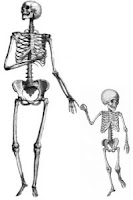Bones give us the structure we have in our bodies. They are accountable for our daily activities, growth, storing calcium, protecting vital organs and much more. Research has come a very long way, at least about 15 years or so. However, there are two controversial sides on how often our bones replenish themselves. One side believes, because our bones are different since birth, we have much less bones now and adult skeletons replace themselves about every 10 years. The alternate side believes the entire human body replaces itself about every 7 years.
One online explanation, I found discussing the differences between children bones and adult bones was on a medical site. (Children’s Healthcare of Atlanta). They explained that, adults have 206 bones in their body, while a newborn baby has roughly 300 bones in theirs. As well as: continuous growth of children's bones, children's ability to heal and reshape them unlike adults. Why? Because babies contain heavy loads of flexible cartilage. As they mature, the cartilage hardens and becomes bone, or the fusing of smaller bones into one whole one. The writer here used their medical platform to engage readers that their statements were true and information that is important to understand for the sake of the audience’s health. This visual was targeted to a curious and help wanting audience. The article presents itself with no oral form of communication since it’s an article with text, They provided a list of specialists and even a URL to look for help. It is clear the writer wanted the reader to be informed of children's bone development and how crucial it can be. Overall, this article was informative and helpful to understand why bones differ as the human body evolves.
One video explanation, (The Skeleton Book) discussed why children's bones differ from adult bones. This video provided a physical doctor orally presenting his explanation to the audience. A nonverbal element used was the hand gestures and body language the professor gives while going over the explanation. They also provided a skeleton in the background to help explain. Although, this video was very informative, it was very short. The web articles were more helpful since they provided more details and URLs, if anyone wanted to investigate further into the topic.
All the sources used media to present their messages using logos, as we the audience were given logical information. The articles were accessed via the web, presented written information and images. The video sources presented their media electronically, orally, & visually. I would recommend a viewer to have the video as a source for a quick fact reminder or a friendly discussion. I would recommend the articles for someone who is writing a paper and needs furthermore precise details.
- Arias, Clemente F., et al. “Bone Remodeling: A Tissue-Level Process Emerging from Cell-Level Molecular Algorithms.” PLOS ONE, vol. 13, no. 9, Sept. 2018, p. e0204171, doi:10.1371/journal.pone.0204171.
“7 Ways Kid Bones Are Different From Adult Bones.” Children’s Healthcare of Atlanta, https://www.choa.org/medical-services/wellness-and-preventive-care/parent-resources/all/7-ways-kid-bones-are-different-from-adult-bones. Accessed 17 Feb. 2020.
The Skeleton Book: Why Does a Baby Have More Bones than an Adult? https://www.youtube.com/watch?v=DMghmH302C8. Accessed 17 Feb. 2020.


No comments:
Post a Comment